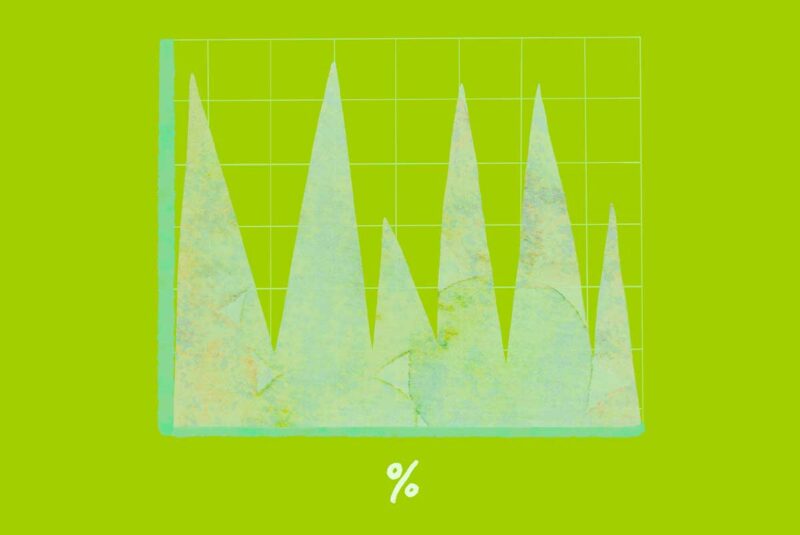When there’s stock market volatility and economic uncertainty in the air, it’s nice to have somewhere safe to park your money that will also provide a return on investment. This is especially true if you have a lower risk tolerance and want to avoid potentially losing money in the short-term.
Some investments can be made by visiting your local bank branch. Others can be bought online directly from the Federal government, while others require you to have a trading account or work with a brokerage.
Whatever route you choose, these are 10 safe investments that provide a higher return than a regular savings account and some of the pros and cons of investing in them.
1. High-Yield Savings and Money Market Accounts
High-yield savings and money market accounts are essentially the same as a regular savings account you have at the bank. However, these accounts offer a higher rate of return or annual percentage yield (APY) compared to a regular savings account.
PROS of High-yield Savings and Money Market Accounts👍
Like regular savings accounts, you’re allowed to withdraw your money when you need it. But you may have a monthly limit on the number of withdrawals you can make.
Assuming your savings account is with a bank that’s insured by the Federal Deposit Insurance Corporation (FDIC) or National Credit Union Association (NCUA), you’re covered for up to $250,000 per account type (savings or checking) should the bank go belly up.[1]
CONS of High-yield Savings and Money Market Accounts👎
Many high-yield savings accounts require a minimum deposit of at least a few thousand dollars to open the account. The idea is that you need to maintain a certain minimum balance at all times or pay a penalty fee.
While interest rates for these accounts are higher than a standard savings account, there’s no guarantee they’ll keep pace with an overall increase in prices.
2. Certificates of Deposit
A certificate of deposit (CD) is another type of savings account. The difference is that you agree to put your money into a CD for a set period of time, usually ranging from 6 months to a year or longer. With a CD, you’re guaranteed a certain rate of return at the end of that time period.
So if you were to put $10,000 into a 1-year CD with a 2% APY, at the end you’d have $10,200.
This may not seem like a lot, but it’s a good way to keep your money safe and earn a little extra at the same time.
PROS of CDs👍
Putting your money into a CD means you know exactly how much you’ll get back.
CONS of CDs👎
If you’re forced to cash out your CD early, you’ll need to pay early withdrawal fees.
If interest rates rise while your money is locked into a CD, you don’t benefit.
3. I Bonds
Series I savings bonds (I bonds) are securities that earn interest based on both a fixed interest rate and an inflation-based rate that’s set semi-annually (twice a year). The bond earns interest until it reaches 30 years or you cash it, whichever comes first.
PROS of I Bonds👍
I bonds can be purchased for as little as $25 and max out at $10,000.[2]
Because Series I bonds are designed to keep pace with inflation, they can make a great gift or help you save for a child’s education.
CONS of I Bonds👎
You can only buy up to $10,000 in I bonds per calendar year.[2]
You only earn the full amount of interest if you hold onto the bonds for 30 years.
4. Treasury Bonds, Treasury Bills
Considered to be the safest investments in the world, Treasury bonds (T-bonds) and Treasury bills (T-bills) offer a safe place to park your money with a modest rate of return.
PROS of Treasury Bonds and Treasury Bills👍
T-bonds and T-bills are based on the U.S. Government’s ability to pay its debts. They’re considered the gold standard for investments.
It’s possible to buy T-bonds and T-bills directly from the U.S. Treasury Department website (treasurydirect.gov), or they can be included in bond exchange traded funds (ETFs) and other investments.
CONS of Treasury Bonds and Treasury Bills👎
T-bonds and T-bills can take between 10 – 30 years to mature.
While T-bonds and T-bills offer a decent return, it may not always keep pace with inflation.
5. Treasury Inflation-Protected Securities (TIPS)
Treasury Inflation-Protected Securities (TIPS) are like Treasury bonds, except they’re adjusted based on changes to the Consumer Price Index.
If inflation causes prices to go up, you can earn more. If inflation causes prices to drop, you may earn less.
PROS of TIPS👍
Because the value of TIPS adjusts, your investments will keep pace with inflation. This is especially important for those on a fixed income.
If the value of your investment falls with a drop in inflation, you’re guaranteed to get your principal back.
CONS of TIPS👎
While T-bonds offer a consistent rate of return, the rate of return on TIPS can change based on inflation. So you won’t know how much of a return you’ll see from one period to the next.
6. Municipal Bonds
A municipal bond, or “muni,” is a type of security used by cities, states and other government entities to raise money for roads, bridges, schools and other infrastructure improvements.
PROS of Municipal Bonds👍
Because you’re investing in your community, you don’t have to pay federal taxes on capital gains from municipal bonds.
Typically, government entities are financially stable and will pay out as promised.
CONS of Municipal Bonds👎
Though it doesn’t happen often, if the government entity issuing the bond defaults, you risk losing your money.
7. Corporate Bonds
Corporate bonds are issued by corporations and offered to investors to raise capital for a specific project. You receive a pre-established number of interest payments at a predetermined interest rate. When the bond reaches maturity, you get your principal back.
PROS of Corporate Bonds👍
Bonds are different from individual stocks, which give you a share of ownership in the company and are indexed to the company’s value on a specific stock exchange, like the S&P 500.
CONS of Corporate Bonds👎
If your bond has a variable interest rate, you risk earning less interest if there’s a drop in interest rates.
Corporate bonds may default if the project the corporation is raising money for falls through. Corporate bonds are usually rated from AAA (best) to “Junk” (worst). The lower the rating, the greater the risk.
8. Money Market Funds
Essentially, a money market fund is like a mutual fund because it invests in lower risk investments – such as Treasury bonds, highly rated securities and cash equivalent securities. It’s like a combination of low-risk investments, but you don’t have to wait as long for them to mature.
PROS of Money Market Funds👍
Like most mutual funds, a money market fund can be sold and traded.
CONS of Money Market Funds👎
Because money market funds invest in low-risk investments, they won’t provide as high of a return as other types of mutual funds or ETFs.
Unlike some of the options on this list, some money market funds aren’t FDIC insured.
9. Dividend Stocks
Dividend stocks are shares in a publicly traded company that’s consistently profitable and has a history of sharing profits with investors through dividend payments.
PROS of Dividend Stocks👍
Dividend stocks are considered less risky than growth stocks because the company has a solid record of earning profits and passing dividends to shareholders.
Dividend stocks are deemed safe because they invest in companies with a long history of stable operation.
CONS Cons of Dividend Stocks👎
While a company may have a history of offering regular dividends, there’s no guarantee it will continue to do so.
If a company is unable to maintain its value, or racks up too much debt and is forced to declare bankruptcy, this can interrupt its ability to pay dividends.
10. Preferred Stocks
Preferred stocks are often called “hybrid” securities because they give you both the stability of a bond and an interest in the company like stock.
PROS of Preferred Stocks👍
Like bonds, you receive a regular interest payment or dividend on a monthly, quarterly or semi-annual basis.
As a preferred stock holder, you’re at the front of the line when the company offers payouts.
CONS of Preferred Stocks👎
Even though preferred stocks are considered less risky than common stock, they also carry greater risk than bonds.
Preferred stock isn’t available to the general public like common stock, so you may not be able to buy shares.
Lower Risk vs. Diversification
Keep in mind that these investment options aren’t right for everyone. Retirees may want a safer investment portfolio because their bottom line is to hold onto what they’ve saved and protect it against market fluctuations.
But if you’re relatively young, playing it safe isn’t always the best approach. Instead, you need to have a diversified portfolio that takes your longer time horizon into account and allows you to balance high-risk and low-risk investments. You don’t need to go all in on cryptocurrency. Having a mix of higher-risk investment vehicles, like stocks and real estate investment trusts (REIT), can help you meet your financial goals while keeping your money safe.
Whatever your investment strategies, it’s always a good idea to work with a financial advisor or other investment professional, especially as a beginner.
The Short Version
- Considered to be the safest investments in the world, Treasury bonds (T-bonds) and Treasury bills (T-bills) offer a safe place to park your money with a modest rate of return
- If you’re relatively young, playing it safe isn’t always the best approach. Instead, you need to have a diversified portfolio that takes your longer time horizon into account
- Whatever your investment strategies, it’s always a good idea to work with a financial advisor or other investment professional, especially as a beginner
Federal Deposit Insurance Corporation. “FDIC: Your Insured Deposits.“ Retrieved August 2022 from https://www.fdic.gov/resources/deposit-insurance/brochures/insured-deposits
Treasury Direct. “Series I Savings Bonds.” Retrieved August 2022 from https://www.treasurydirect.gov/savings-bonds/i-bonds/




